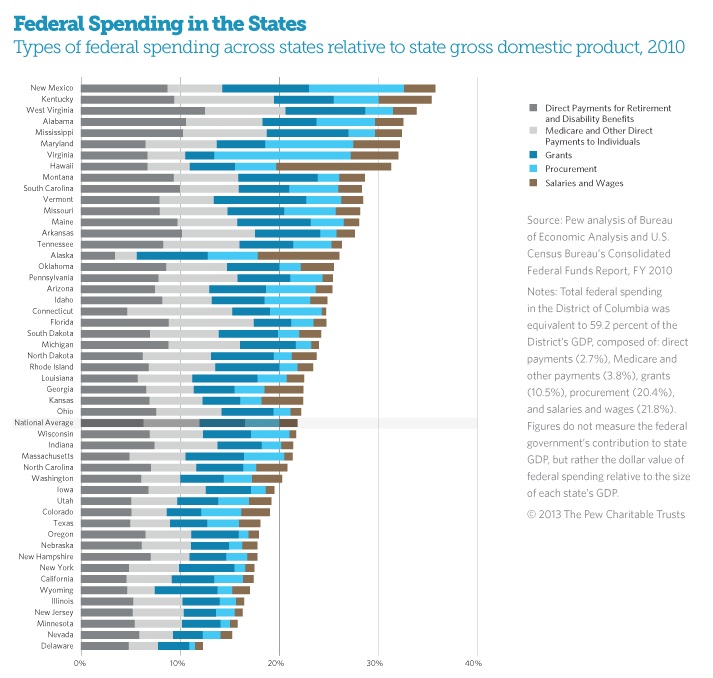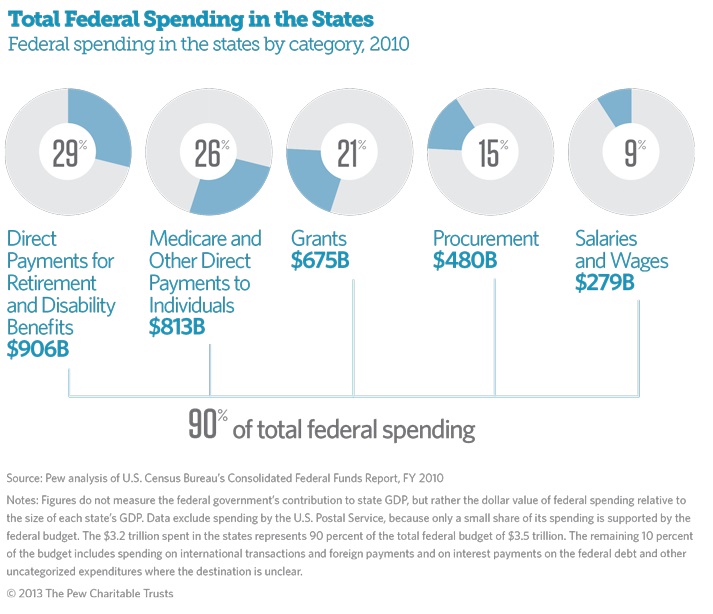Economic Importance of Federal Spending Varies Widely Across States
Federal spending that can be identified at the state level accounted for more than 90 percent of the total federal budget, or $3.2 trillion of the $3.5 trillion total in 2010.1 This figure includes direct payments to individuals, government procurement, federal employee salaries and wages, and grants to states. Such spending was equivalent to about one-fifth of total domestic economic activity in 2010.
Note: This fact sheet was updated on September 23, 2013.

The magnitude of this spending relative to each state’s economy ranged from 35.8 percent of New Mexico’s state gross domestic product to 12.3 percent of Delaware’s. Federal spending in the District of Columbia was equivalent to 59.2 percent of the District’s economy—significantly larger than for any of the 50 states.
The relative magnitude of each type of spending varies widely across states. In Mississippi and Maryland, for example, total federal spending was equivalent to 32.3 percent of GDP, but the composition of that spending differed. Federal grants equaled just 4.9 percent of Maryland’s state GDP compared with 8.2 percent of Mississippi’s, while federal procurement represented 8.9 percent of Maryland’s GDP and just 2.7 percent of Mississippi’s. This means Mississippi could be more vulnerable to federal grant cuts, while Maryland could be more vulnerable to procurement cuts.

Federal spending identified by state comprises five categories:
- Direct payments for retirement and disability benefits. Social Security payments, veterans benefits, and other federal retirement and disability payments to individuals. Social Security retirement payments account for 48 percent of this category.
- Medicare and other direct payments to individuals. Medicare benefits, food assistance, unemployment insurance benefits, student financial assistance, and other programs for individuals. Medicare accounts for 60 percent of this category.
- Grants. Funding to state and local governments for a variety of program areas including health care (largely Medicaid), transportation, education, and housing. In addition, a small share of federal grants goes to nongovernmental organizations.
- Procurement. Contracts with nongovernmental entities to purchase a wide range of goods and services, from military and medical equipment to food services. Defense purchases account for almost two-thirds of total procurement spending.
- Salaries and wages. Salaries and wages for military and civilian federal employees, divided roughly equally between the two types.
Endnote
1The remaining 10 percent of the budget includes spending on international transactions and foreign payments and on interest payments on the federal debt and other uncategorized expenditures where the destination is unclear. Source: Pew analysis of U.S. Census Bureau’s Consolidated Federal Funds Report, FY 2010, and Office of Management and Budget data.











